Have you ever had an experience where, when looking back at it, you feel envy for the earlier version of you that got to experience it?
I had never imagined I could be jealous of myself until after I stepped out of the Corsa yellow Lamborghini Huracan I had just pushed beyond my experience of everyday physics during an exhilarating five laps at the historic Sebring Motor Speedway.
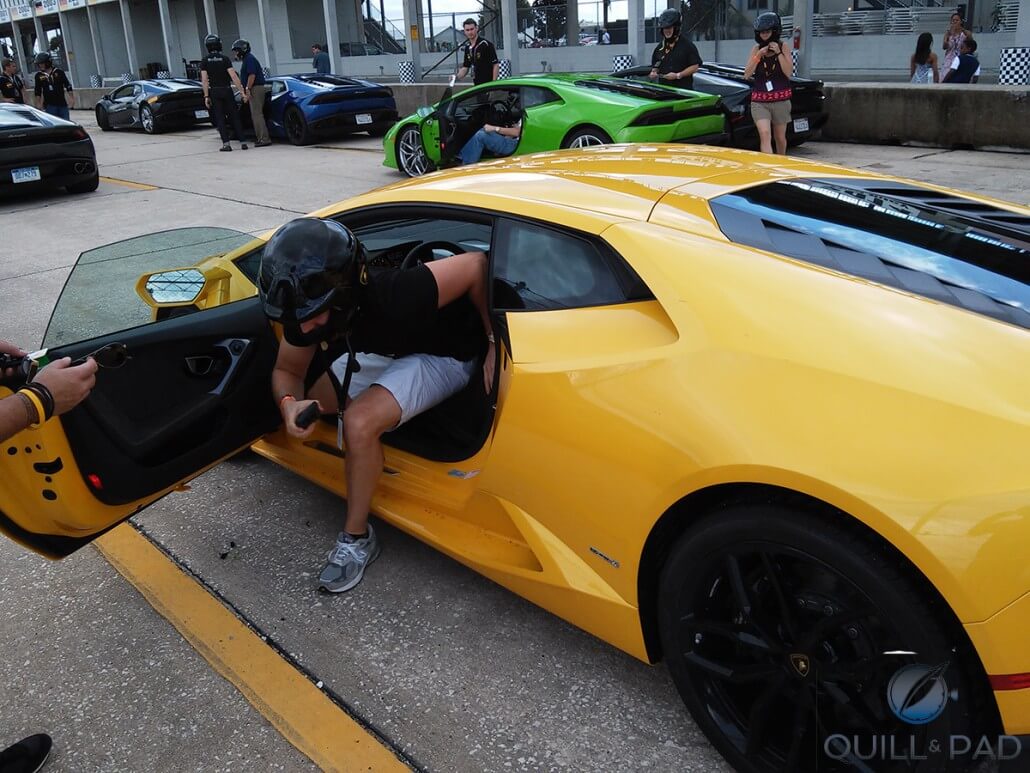
The author exits a Corsa yellow Lamborghini Huracan during the Blancpain Lamborghini Super Trofeo world finals weekend at the Sebring Motor Speedway
The time behind the wheel of the Huracan changed me forever, and I immediately burned to be the guy that had been in the car, not the guy now walking away from it. But that’s reality: every moment is fleeting, no matter how strong the rush of adrenaline or the thrill of victory.
My weekend at the Blancpain Lamborghini Super Trofeo World Finals at Sebring Motor Speedway was packed full with moments that I will always treasure.
The 2015 season of the Blancpain Lamborghini Super Trofeo came to an exciting end during the weekend of November 20-22. I was lucky to be invited by Blancpain to witness the culmination of months of hard work and dedication by more than sixty drivers and dozens of teams.
This race weekend ended the seventh year of the series, which fielded the largest number of cars ever: 84 cars participating in North America, Europe, and Asia. This is almost double the participation of just two years ago and eight times the number of drivers in the first series in 2009, when there were only eleven cars racing in the then solely European event.
The Super Trofeo has grown strongly since then, expanding into Asia in 2012 and North America in 2013. That was also the first year of the world championships, which were held at the Autodromo Vallelunga racetrack in Italy.
This year, the 66 cars vied for one of the few podium positions on the historic track in Sebring, Florida.
Where it began
The interesting part (beside the racecars and a whole heap of race tech, obviously) is how Blancpain and Lamborghini started this relationship in the first place. According to a Blancpain representative, one of the eleven cars that took part in the inaugural season was owned and driven by none other than Marc Hayek, Blancpain’s CEO and grandson of the late Nicholas G. Hayek.
Marc Hayek loved the series so much that he wanted to help make the Super Trofeo truly super, and a young but legendary partnership was formed.
The series has become a true motorsport series too, with drivers coming from Formula 1, IndyCar, the GT series, and even Nascar.
Some Super Trofeo drivers have even gone on to drive in the GT3 and LeMans series. According to automotive journalist Jan Tegler, the Super Trofeo Series is one of the best places to see incredible racing skill while being able to get up close and personal with the teams.
The Super Trofeo series actually is one of the fastest-growing sports car series thanks to forethought on the part of Lamborghini. The Italian supercar brand created the Young Drivers program around the same time as the new Huracan model was launched, all with the intent of fostering driving skill and providing a launching ground to all GT racing around the world.
Some of the Super Trofeo World Finals champions are in that Young Drivers program.
The series really owes its success to the Huracan platform, succeeding the Gallardo as the go-to model of the Super Trofeo. Following the 2015 season, the entire series will transition to include only the Huracan model.
The LP 620-2 Super Trofeo model of the Huracan provides an ideal base for GT racing and is remarkably better suited than its predecessor, the Gallardo, as it is newly designed from the ground up for a bigger and more stable wheelbase while being lighter and having better weight distribution. The gearbox and clutch system are dramatically improved over the Gallardo, and the braking and traction control systems are much more adjustable and finely tuned for a racing set up.
A big upgrade is the Huracan’s engine management system and ECU, which provide almost 50 more horsepower than the Gallardo for a much better power-to-weight ratio. Basically, the Huracan Super Trofeo is a more honed and capable machine and much better suited as a racecar base than its predecessor.
Thanks to growing interest and the huge success of the Huracan platform, the series showcases a very pure form of racing where a single make of car levels the playing field and allows for the fine tuning of components based on a driver’s skill and passion, as well as the team’s knowledge of physics. Seriously cool stuff.
The team’s knowledge of physics? Really? Oh, yeah.
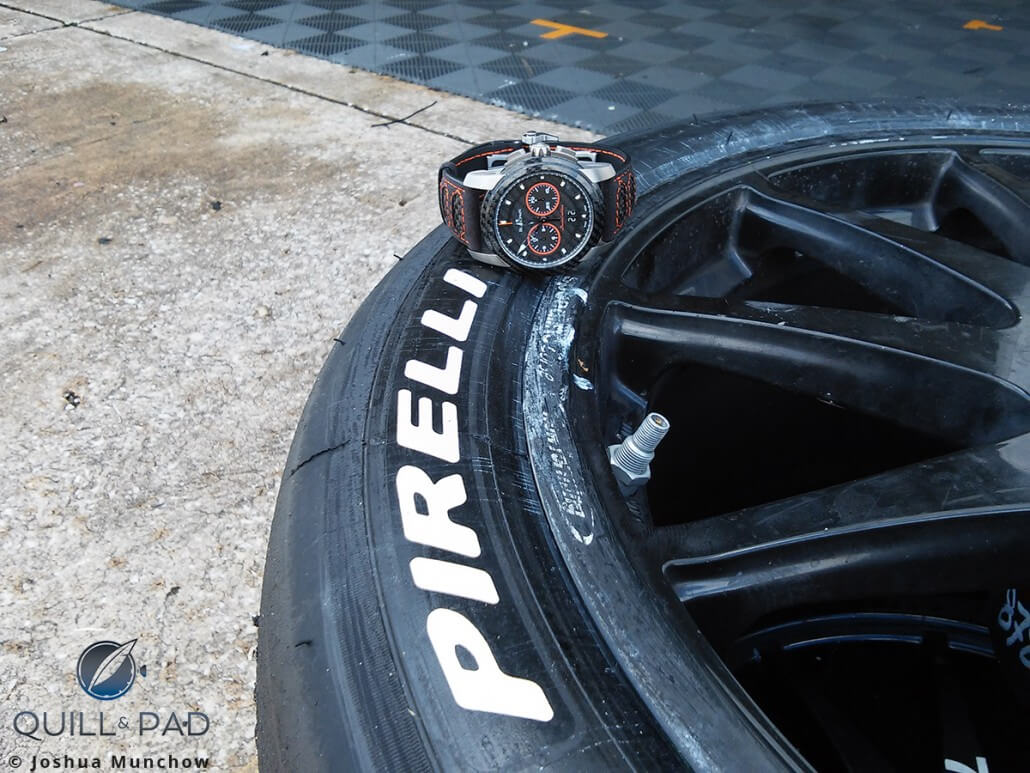
The limited edition Blancpain L-evolution R Chronograph Flyback Grand Date resting on a Lamborghini’s Pirelli P-Zero
This racing series is a pretty good example of the science involved in racing and the technology that goes into its development.
Just take the wheels and tires, the ever important connection to the racetrack. The famous P-Zero tires supplied by Pirelli – and not the ones you can buy at the tire store, these are the true racing tires specifically designed for each model of Lamborghini – and the tire techs are extremely knowledgeable about the characteristics of use and wear of racing tires.
Nerdy tech talk
The tires are initially filled to about 2 bar (28 pounds per square inch) and balanced to within a tolerance of 5 grams of being perfectly balanced. A driver can usually feel about 10 to 15 grams of off-balance vibration, so these are tuned better than can be felt.
Next, the teams take the tires and bleed off the pressure down to the cold starting pressure, somewhere in the vicinity of 21 psi. The reason they start with low pressure is thanks to heat and expansion, the tire pressure can increase by up to 15 psi as the tires warm up, hopefully hovering near the ideal pressure of 32 psi. The temperature difference between the inside of a tire and the outside can be up to 20 degrees, usually around 190 degrees inside and 180 degrees outside.
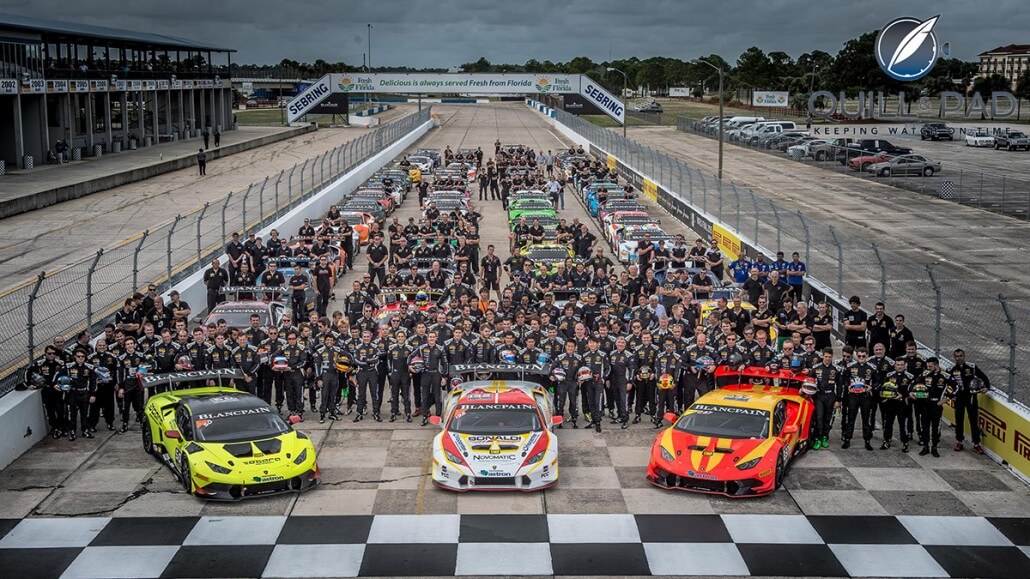
The drivers participating in the Blancpain Lamborghini Super Trofeo World Finals at Sebring Motor Speedway
That temperature is largely built up by radiant heat from the massive steel brakes, the lateral and torsional forces applied to the tires under cornering, braking, and acceleration, and the friction caused by the rough track. And even those forces get finely tuned thanks to genius mechanics.
The wheels have a camber angle (the tilt on a wheel from perfectly vertical) averaging between 3 to 5 degrees, usually less on the front than the rear, which helps the car grip in corners. As the lateral force of cornering causes the car and the wheels to twist and lean over, more of the outside tire comes into contact with the pavement, increasing grip when most other cars would lose grip.
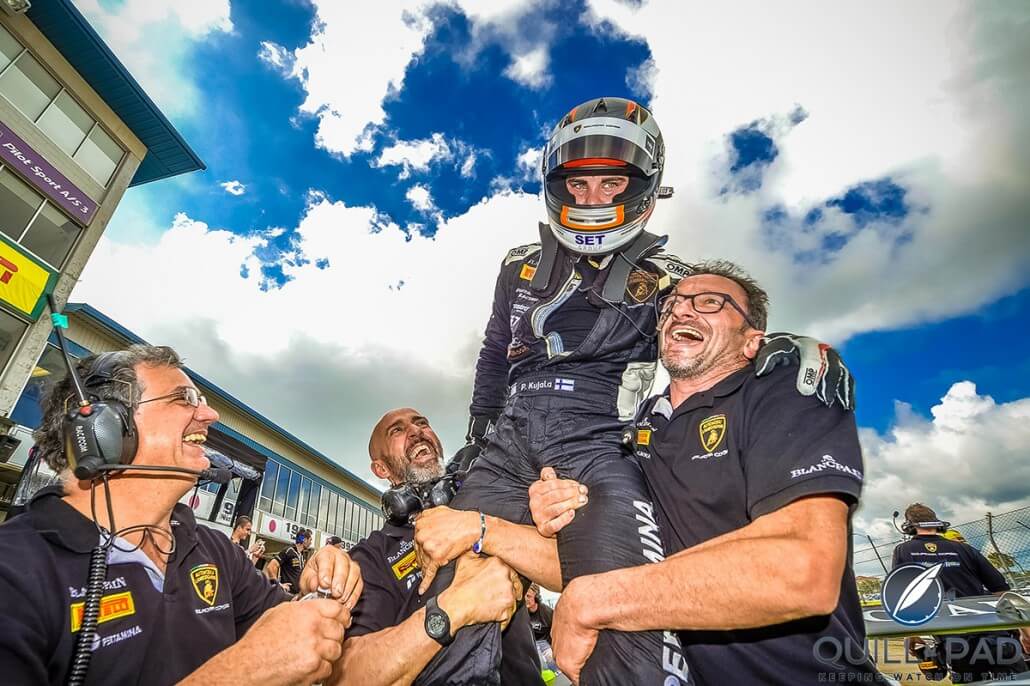
The winner of the 2015 Blancpain Super Trofeo Pro category, Finnish driver Patrick Kujala, lifted high in celebration
Sticking to the pavement and cutting those corners hard
And for even more grip we have the downforce provided by the giant rear wing and front lip. In Lamborghini street cars, most people will never notice any appreciable downforce from these mostly cosmetic additions.
However, on a Super Trofeo model going 300 km/h (180 mph), when the driver simply lifts off the gas the downforce can feel like he just slammed on the brakes. This is a force that is also finely tunable thanks to many possible adjustments on both components, and the additions of diffusers on both the front and rear. These combine to form various effects of drag, turbulence, and downforce, all of which teams up to achieve the perfect balance of speed and drag for a tightly handling machine.
Combined with hundreds of other small adjustments and tuning, the driver plays a large role in how the car actually operates on the track. It seems obvious, but drivers have much more control over the car’s systems during actual racing than many may know.
There are a variety of buttons on the steering wheel allowing, for example, the ability to adjust and/or turn off traction control depending on conditions, the area of the track, or how the car is responding at any given moment. All of the drivers have a specific style of driving and racing, and so the adjustments aren’t considered right or wrong, but are tuned to a specific driving style and the driver’s preferences.
That is why racing is as much of an art as a science, every day and every track are different, as is every driver. There is no perfect setup, only those that are more or less appropriate for some drivers more than others.
I love when science and art combine to make something as exciting as racing. I also love when the passion of those interested in this art and science combo breaks free and you can feel the enthusiasm around you.
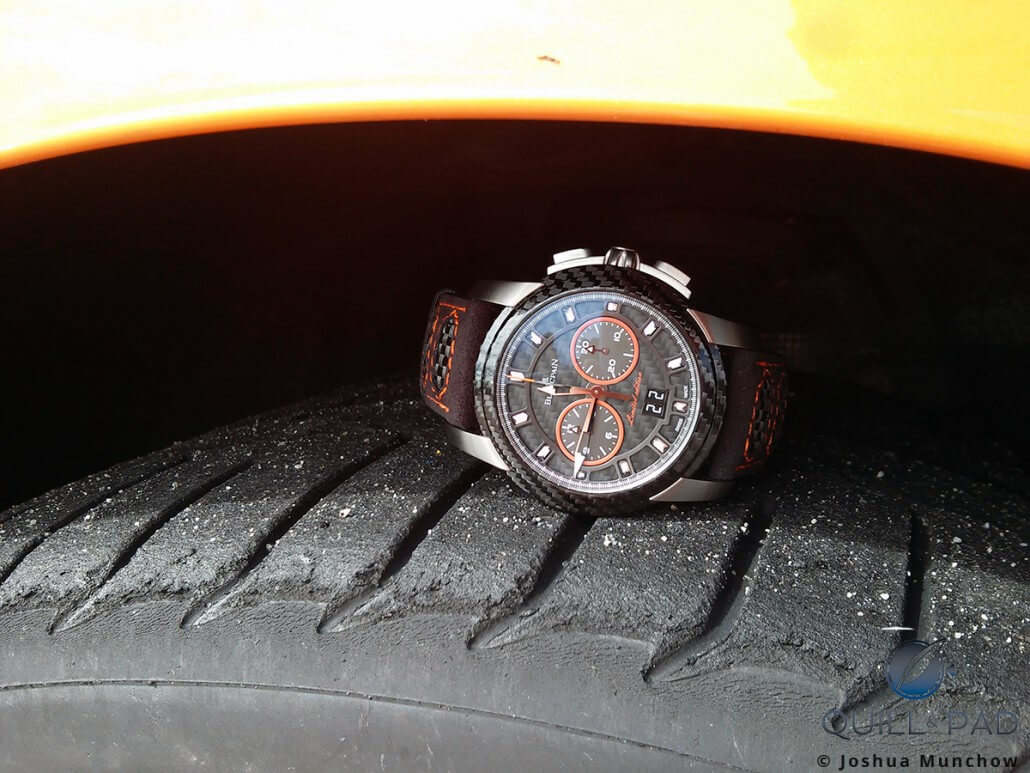
The limited edition Blancpain L-evolution R Chronograph Flyback Grand Date resting on the tire of a Lamborghini Huracan
The watch connection is clear
The horological connection was most apparent when the racing folk mingled with the watch folk and true nerd conversations spilled over everywhere. Racing people work on finely tuned machines, just like the watchmakers, so there was always something to talk about.
Visitors seemed to show more interest in the actual mechanics and technical specifications of the watches on display than many Baselworld attendees ever indicate. It was a definitive example of why this relationship works.
I was also lucky enough to spend some time looking at a variety of models and test drive an L-evolution R Chronograph Flyback Grand Date limited edition in titanium and carbon fiber. This timepiece was an awesome companion as I watched the final two races of the weekend, timing lap times for the leading cars until one blew a tire and the other spun out wide, losing position.
The watch proved that the fight was real as times varied from lap to lap. Utilizing the flyback function when I switched to timing a different car was easy and the feeling on the wrist was definitely race-ready.
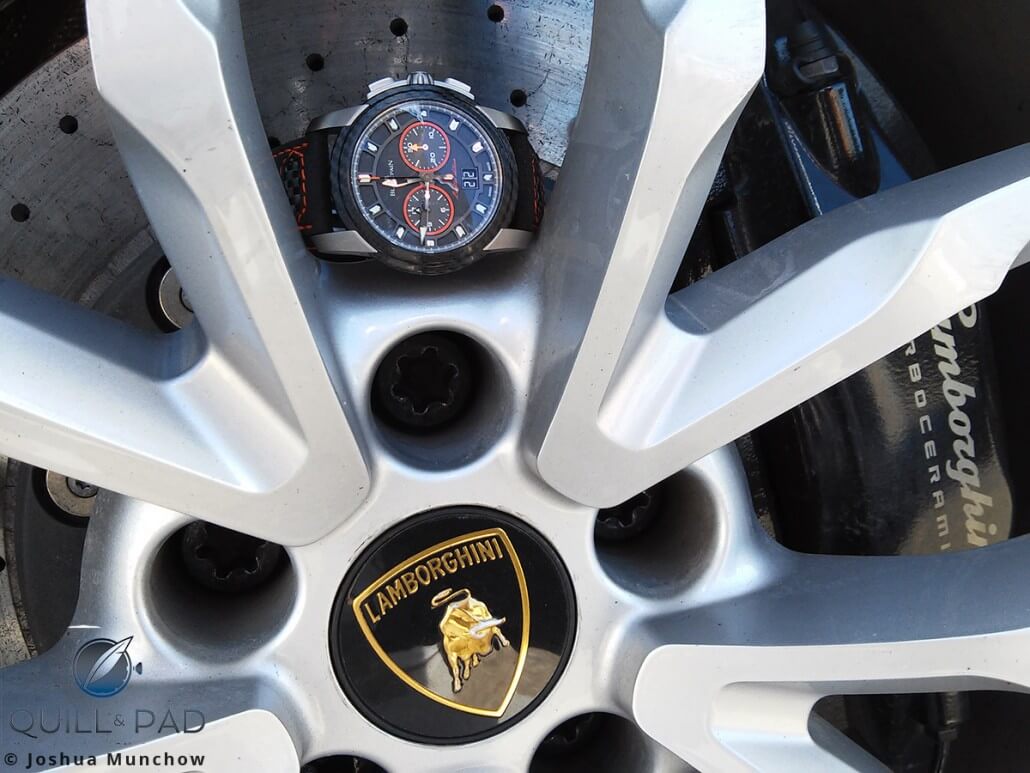
Between the spokes: the limited edition Blancpain L-evolution R Chronograph Flyback Grand Date and a Lamborghini Huracan
The carbon fiber paired with the titanium and the Alcantara strap make for rather light watch. The vertical clutch manufacture chronograph movement ticking away inside, providing a consistent and sound mechanical heart. It felt so natural on my wrist that when I sat down in the Huracan to take a few laps, it fit right in with the dual clutch system the Lamborghini was sporting.
In fact, the similarity between the two in regards to materials and purpose was immediately evident from the moment I strapped the watch on.
But I will admit that the moment I stepped on the gas and roared down the pit lane following the Lamborghini team driver and another journalist headed for turn one, I forgot all about the watch, the fascinating details of race technology, and pretty much everything except for what was ahead of me.
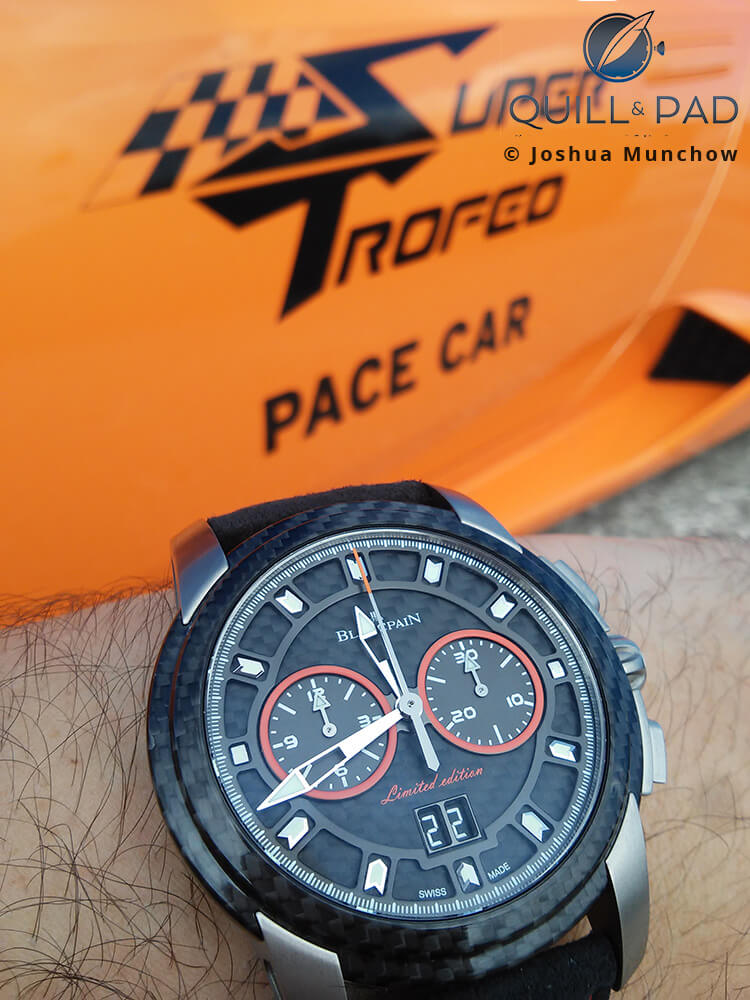
The limited edition Blancpain L-evolution R Chronograph Flyback Grand Date and the Super Trofeo’s pace car
At moments, words of advice drifted into my head: “Brake hard before the turn, go deep into the corner and power into the turn and let the all-wheel drive pull you through” (which it did); “stay relaxed but focused, don’t overwork the car” (which I surprisingly accomplished); “and most of all have fun” (which I most definitely did).
Those words of advice came from multiple sources, including Tegler, who was in a midnight-black Huracan directly in front of me. Knowing I had a professional racecar driver followed by an accomplished amateur racecar driver ahead of me made me much more confident. While I may not have matched their speed, cornering, and braking ability, I definitely was able to follow their line and have a whole heaping pile of fun.
And in the end, after all was said and done, the races raced, and the season over, that is what this weekend boiled down to: fun.
The time with friends and new acquaintances, talking with racecar drivers and mechanics alike, learning about a sport that is much nerdier than many might admit, the weekend was about fun for everyone. This was seen most clearly at the awards dinner, when all the teams were laughing, joking, smiling, and enjoying time with like-minded souls. There were no words of anger even between races or before important moments for entire teams.
People were serious, of course, but they were all having fun.
I want to thank everyone involved with the weekend for a time I’ll never forget. Amazing watches, amazing cars, amazing racing, and amazing fun. What more could a guy ask for?
Hmm, maybe one more drive in that Corsa yellow Lamborghini Huracan . . . yeah, that wouldn’t be too bad.
For more information on the series or the timepieces, please visit www.blancpain.com.
Quick Facts
Case: 43.5 x 12.9 mm, titanium and carbon fiber
Movement: automatic Caliber 68F5
Functions: hours, minutes; date, flyback chronograph
Limitation: 88 pieces
Price: $20,200
Trackbacks & Pingbacks
-
[…] Hayek admitted at the time that he thought it would have been a better fit for Breguet at the beginning, but says he discovered a natural side to this partnership – like that which grew between Blancpain and Italian exotic car manufacturer Lamborghini (see You Are There: Blancpain Lamborghini Super Trofeo World Finals At Sebring). […]
Leave a Reply
Want to join the discussion?Feel free to contribute!

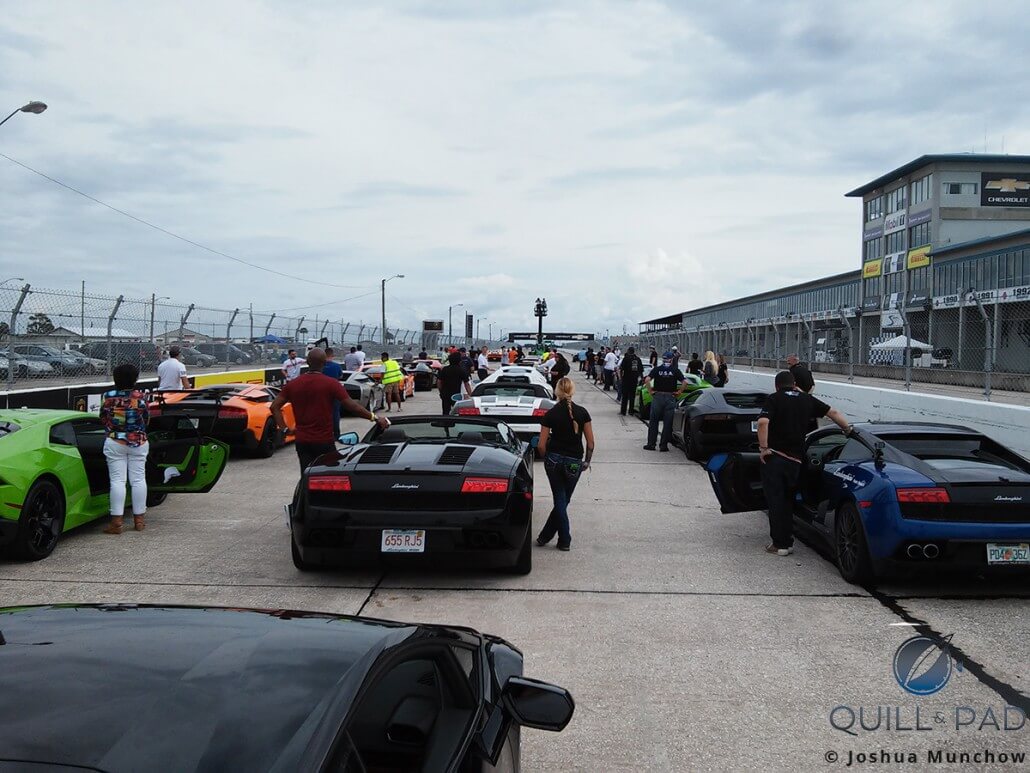
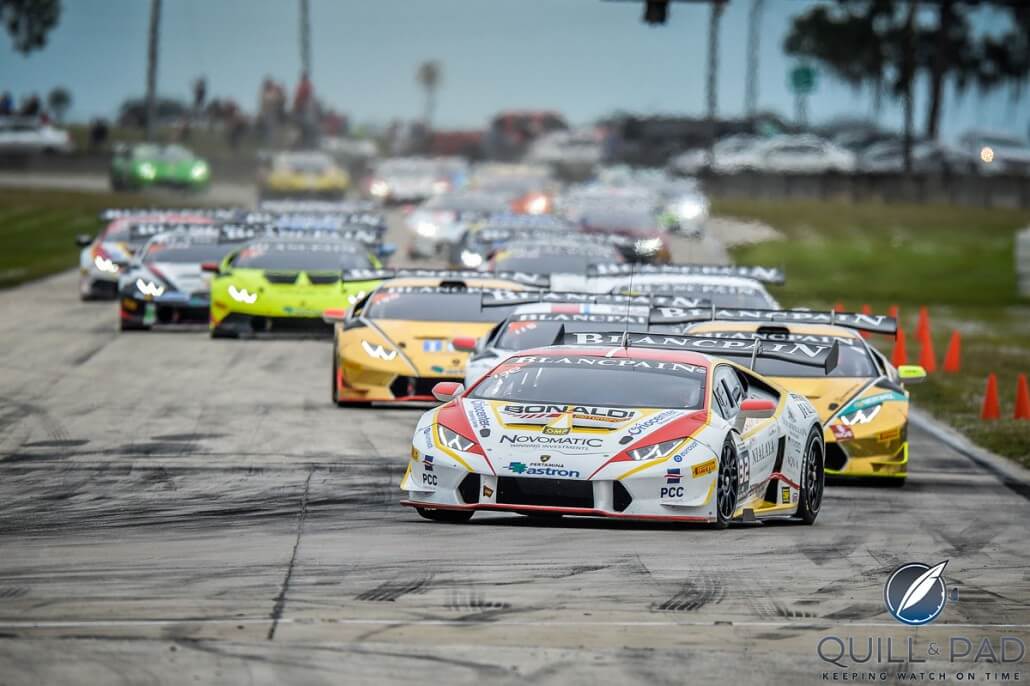
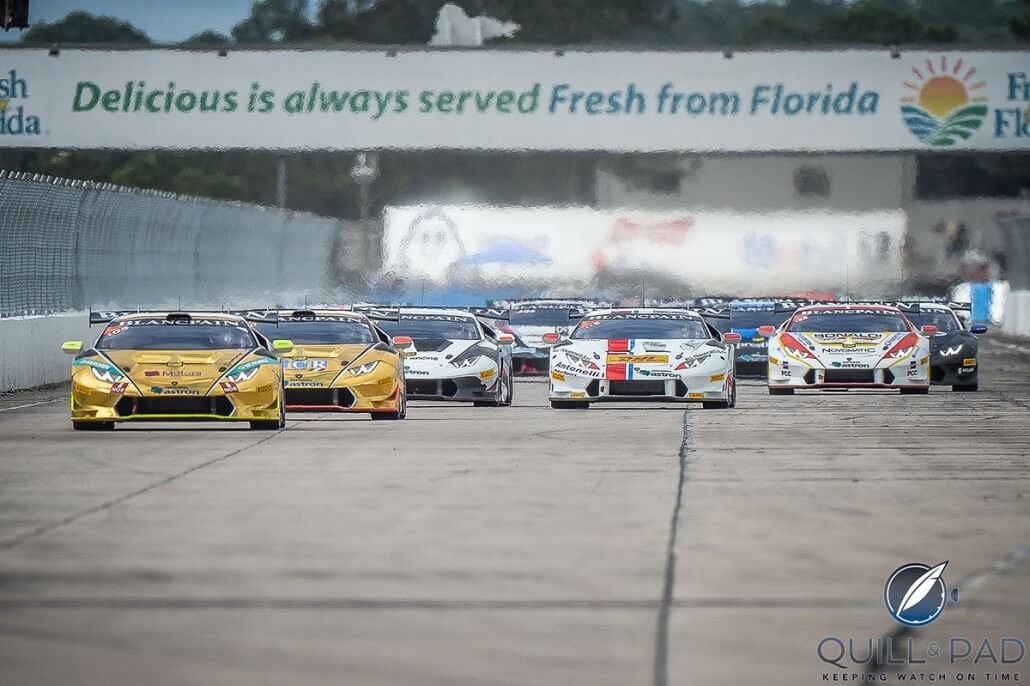
Its lovely but l prefer 60-01richard mille,
If I have the money I’ll buy it and use,.
I will never use the fake one even if it looks like the real/original one. I believe will get one day in my life time.